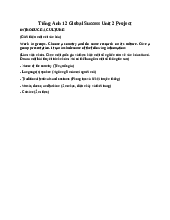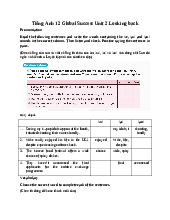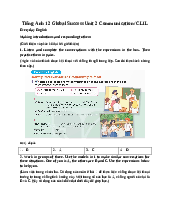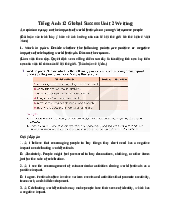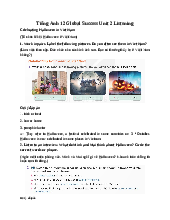



Preview text:
Tiếng Anh 12 Global Success Unit 2 Speaking
Planning a Cultural Diversity Day
(Lên kế hoạch cho Ngày Đa dạng Văn hóa)
1. Work in pairs. Discuss the differences between Vietnamese culture and some
other cultures you know about. Use the ideas in Getting Started and Reading, and
the table and examples below to help you.
(Làm việc theo cặp. Thảo luận về sự khác biệt giữa văn hóa Việt Nam và một số nền văn
hóa khác mà bạn biết. Sử dụng các ý tưởng trong phần Getting Started, phần Reading,
bảng và các ví dụ bên dưới để giúp bạn.) Gợi ý đáp án Country Vietnam South Korea The UK Cuisine
pho, bun cha, spring kimchi, tteokbokki fish and chips, roast rolls beef, curry, haggis Music
folk music, chau K-pop, folk music, British pop, classical van, pop music classical music music, folk music Traditional ao dai/ ao tu than hanbok the Scottish kilt clothing
Similarities and differences between Vietnam and South Korea
- Similarities: People in both countries eat rice and noodles, a lot of vegetables, and
soups. We both use chopsticks; however, while we use wood or bamboo chopsticks,
South Korea eat with metal chopsticks. Street food is a big part of both cultures. We both
worshop ancestors, celebrate Lunar New Year, Mid-Autumn Festival, and Buddha’s
Birthday. Both nations also have their traditional clothing. - Differences:
Koreans like spicy food while not all Vietnamese eat spicy dishes (except people
from some provinces in the Middles or South Vietnam)
Music: Traditional Vietnamese music is mainly used for religious activities, in
daily life, and in traditional festivals. There are many music forms due to Vietnam’s
numerous ethnic groups. These music forms include royal court music, dilettance
music, folk music, cheo, quan ho, chau van, etc. Traditional Korean music is
typically classified into several types: the “legitimate music” (called jeongak or
jeongga) enjoyed by the royalty and aristocracy of Joseon; folk music (court music
and dance) performed for the King at celebratory state events; music and dance
connected with shamanic and Buddhist and peotic songs beloved of the educated elite.
Traditional clothing: Korean women wear hanbok while Vietnamese women wear ao tu than or ao dai.
2. Work in groups. Your school is organising a Cultural Diversity Day. Discuss what
the event should include. Use the ideas in 1 to create the event programme.
(Làm việc nhóm. Trường học của bạn đang tổ chức Ngày đa dạng văn hóa. Thảo luận về
những gì sự kiện nên bao gồm. Sử dụng những ý tưởng ở bài 1 để xây dựng chương trình sự kiện.) Gợi ý đáp án
A: We've decided to organise a Cultural Diversity Day in our school. Let's discuss what activities to include.
B: How about having cultural performances? We could invite students to showcase
traditional dances, music, or even theater from various cultures.
C: That's an excellent idea! We can create a schedule for performances throughout the
day. It will be a fantastic way for everyone to experience the richness of different cultures.
D: To involve everyone, let's organize a multicultural fashion show. Students can
showcase traditional clothing or even modern outfits inspired by their cultural heritage.
A: Excellent suggestion! We could also incorporate technology by creating QR codes for
each culture, linking to short videos or presentations that provide more in-depth insights
into their customs, traditions, and celebrations.
3. Report your group's ideas to the whole class. Vote for the best Cultural Diversity Day programme.
(Báo cáo ý tưởng của nhóm bạn cho cả lớp. Bình chọn cho chương trình Ngày Đa dạng văn hóa tốt nhất.) Gợi ý đáp án
Hi, everyone! We've decided to organise a Cultural Diversity Day in our school, so we
have discussed what activities to include, and the following ones are our suggestions. For
cultural performances, we could invite students to showcase traditional dances, music, or
even theater from various cultures. We can create a schedule for performances throughout
the day. It will be a fantastic way for everyone to experience the richness of different
cultures. To involve everyone, we will organize a multicultural fashion show. Students
can showcase traditional clothing or even modern outfits inspired by their cultural
heritage. Finally, we could also incorporate technology by creating QR codes for each
culture, linking to short videos or presentations that provide more in-depth insights into
their customs, traditions, and celebrations. We hope you will vote Cultural Diversity Day
programme for the best. Thank you very much for listening.
